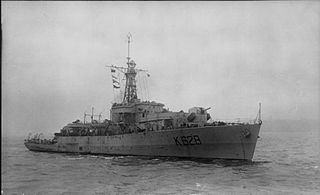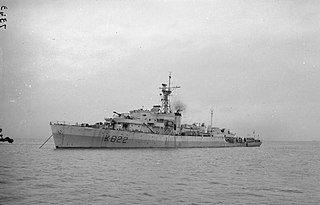
HMS Loch Alvie was a Loch-class frigate of the Royal Navy, named after Loch Alvie in Scotland. She was ordered by the Royal Navy during World War II, but did not see action with them, having transferred to the Royal Canadian Navy before commissioning. After the war she returned to the Royal Navy and would pass in and out of service until 1963.

HMS Loch Dunvegan was a Loch-class frigate of the British Royal Navy, named after Loch Dunvegan in Scotland. Launched in 1944, the ship saw service in the Second World War, and in the Mediterranean Fleet in the early 1950s, before being broken up in 1960.

The sixth HMS Bulwark of the Royal Navy was a 22,000 tonne Centaur-class light fleet aircraft carrier. Initially commissioned as a light aircraft carrier in 1954, the ship was converted into a commando carrier in 1958 and recommissioned as such in 1960. Bulwark remained in this capacity until 1979 following failed efforts to sell the ship, Bulwark re-entered service as an anti-submarine warfare carrier and remained as such until being decommissioned in 1981. The ship was scrapped in 1984.

HMS Loch Fada was the lead ship of the Loch-class frigates of the British Royal Navy, built by John Brown & Company of Clydebank, Scotland, and named after Loch Fada in the Inner Hebrides.

HMS Loch Insh was a Loch-class frigate of the Royal Navy, named after Loch Insh in Scotland. She was built by Henry Robb of Leith and launched on 10 May 1944. After service at the end of World War II she was decommissioned, but reactivated in 1950 and served, mostly in the Persian Gulf, until 1962. The ship was sold to the Royal Malaysian Navy in 1963, and renamed KD Hang Tuah (F433). She was scrapped in 1977.

HMS Loch Killisport (K628/F628) was a Loch-class frigate of the British Royal Navy, named after Loch Killisport in Scotland. Launched in 1944, the ship was not commissioned until July 1945, and served in post-war repatriation operations in the Far East until decommissioned in April 1946. During this time Prince Philip was an officer on board this ship. Recommissioned in 1950 she served in the Home Fleet for two years, before being extensively modernised for service in the Persian Gulf and Far East. Decommissioned in August 1965, she was sold for scrapping in 1970.
HMS Morecambe Bay was a Bay-class anti-aircraft frigate of the British Royal Navy, named after Morecambe Bay on the north western coast of England. In commission from 1949 until 1956, she saw active service in the Korean War, and was sold to Portugal in 1961 to serve as NRP Dom Francisco de Almeida until 1970.

HMS Galatea (F18) was a Leander-class frigate of the Royal Navy. She was built by Swan Hunter & Wigham on the Tyne. She was launched on 23 May 1963 and commissioned on 25 April 1964 and was the 8th ship of the Royal Navy to bear the name.

HMS Wild Goose, pennant number U45, was a Black Swan-class sloop of the Royal Navy. She was one of several ships of that class that took part in the famous "six in one trip" in 1943.

HMS Burghead Bay was a Bay-class anti-aircraft frigate of the British Royal Navy, named for Burghead Bay in Morayshire.

HMS Cardigan Bay was a Bay-class anti-aircraft frigate of the British Royal Navy, named after Cardigan Bay, off the coast of Ceredigion, Wales.
HMS St Austell Bay was a Bay-class anti-aircraft frigate of the British Royal Navy, named after St Austell Bay on the south coast of Cornwall. In commission from 1945 until 1956, she served in the Mediterranean Fleet and on the America and West Indies Squadron.

HMS Veryan Bay was a Bay-class anti-aircraft frigate of the British Royal Navy, named after Veryan Bay on the south coast of Cornwall. In commission from 1945 until 1957, she saw service in the Pacific, Mediterranean, and Home Fleets, in the West Indies and in the South Atlantic.

HMS Widemouth Bay was a Bay-class anti-aircraft frigate of the Royal Navy, named for Widemouth Bay in Cornwall.

HMS Dalrymple was a Bay-class anti-aircraft frigate of the British Royal Navy, which served as a survey ship, mostly in the Persian Gulf, from 1948 until 1965. She was completed to deal with the large numbers of uncharted wrecks and mines around the British Isles as a result of World War II. For this purpose she was fitted for minesweeping. She was named for the pioneering Hydrographer of the Admiralty Alexander Dalrymple (1737–1808).

HMS Loch Fyne was a Loch-class frigate of the British Royal Navy, built by the Burntisland Shipbuilding Company Ltd, Burntisland, Fife, Scotland, and named after Loch Fyne in Scotland. The ship was launched in 1944, and served at the end of World War II. Recommissioned in 1951, she served in the Persian Gulf and was scrapped in 1970.

HMNZS Rotoiti (F625) was a Loch-class frigate of the Royal New Zealand Navy (RNZN), which had formerly served in the British Royal Navy as HMS Loch Katrine at the end of World War II.

HMNZS Hawea (F422), formerly HMS Loch Eck (K422), was one of six Loch-class frigates that served in both the Royal Navy (RN) and the Royal New Zealand Navy (RNZN). The ship was laid down by Smiths Dock on 25 October 1943, launched on 25 April 1943 and commissioned into the Royal Navy as HMS Loch Eck on 7 November 1944.

HMS Loch Achray was a Loch-class frigate of the Royal Navy. She was built by Smith's Dock Co. Ltd. in South Bank-on-Tees and launched on 7 July 1944. After service in World War II, she was sold to the Royal New Zealand Navy and renamed HMNZS Kaniere (F426) in September 1948. After service in the Korean War, she was used as a training ship from 1957. She was sold in 1966 for breaking up in Hong Kong.

HMS Loch Arkaig was a Loch-class frigate of the British Royal Navy, named after Loch Arkaig in Scotland. The ship was ordered from Caledon Shipbuilding & Engineering Company, Dundee, Scotland, on 2 February 1943, and laid down on 1 November 1943. Launched on 7 June 1944, the ship was commissioned on 1 November 1945, and completed on 17 November. Unlike the rest of the class Loch Arkaig was fitted with Parsons single reduction geared turbines, rather than 4-cylinder vertical triple expansion reciprocating engines. The ship served in the Home Fleet until laid-up and put into Reserve in 1952, and was sold for scrapping in 1959.


















